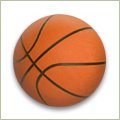In my last entry (The Eyes Have It), I stressed the important contribution that vision plays in the game of basketball.
But did you know that basketball carries one of the highest risks for sports-related eye injury?
Here are the facts:
* The US Consumer Product Safety Commission has reported that, each year in the United States, more than a quarter of a million children under the age of 15 sustain a sports-related eye injury.
* Basketball and baseball are the two sports associated with the most eye injuries in athletes between the ages of 5-24 years old.
* Basketball accounts for almost 1/3 (29%) of all sports-related eye injuries.
* One in ten college basketball players will sustain an eye injury each season.
* More than half of basketball related eye injuries are cuts or scrapes to the eyelid while another 1/3 are bruises to the area around the eyes. Eleven percent are scrapes to the cornea, the clear tissue that covers your eyeball.
* About 7% of sports-related eye injuries require a trip to the emergency room and some even result in permanent loss of sight.
These statistics are not meant to stop you from playing basketball.
But they should get your attention.
So what can you do to reduce your risk of getting poked in the eye when everyone’s reaching/battling for the ball?
According to the Joint Policy Statement from the American Academy of Pediatrics and the American Academy of Opthalmology:
* All athletes and their parents should be made aware of the risks associated with participation in sports. (Just did that!)
* Any athlete with worse than 20/40 corrected vision in one eye MUST wear eye protectors when playing. (Think about it, if you injure your “good” eye, you might never be able to drive a car, let alone drive down the lane).
* Safety sports eyewear should meet the requirements of the American Society for Testing and Materials (ASTM) Standard F803 (just look at the label) for basketball players.
* Safety eyewear should be replaced when it no longer fits correctly, is damaged, or is yellowed with age (because it might no longer be strong enough to protect you).
A few other thoughts:
While contact lenses can improve your vision, they don’t provide any extra protection for your eyes. Appropriate eye protectors should still be worn over them.
Regular “streetwear” glasses that do not have non-breakable polycarbonate lenses can actually increase your risk of a severe eye injury since they are more likely to shatter.
When worn correctly, protective eyewear can reduce the risk of serious injury to your eyes by 90%.
So do your best James Worthy and Kareem Abdul-Jabbar impression and drive the lane with no fear, knowing that you’ve got your eyes covered.
For more information and resources about eye protection and youth sports, go to:
The Coalition to Prevent Sports Eye Injuries
http://www.sportseyeinjuries.com/
Protective Eyewear for Young Athletes
http://aappolicy.aappublications.org/cgi/reprint/pediatrics;113/3/619.pdf
Promoting the Use of Protective Eyewear for Children in Sports
http://www.aoa.org/x7382.xml
Thursday, June 14, 2007
The Eyes Have It -Part II
Subscribe to:
Post Comments (Atom)








No comments:
Post a Comment